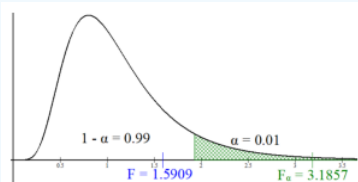9.4: Two Variance or Standard Deviation F-Test
- Page ID
- 27814
9.5.1 The F-Distribution
An F-distribution is another special type of distribution for a continuous random variable.
Properties of the F-distribution density curve:
- Right skewed.
- F-scores cannot be negative.
- The spread of an F-distribution is determined by the degrees of freedom of the numerator, and by the degrees of freedom of the denominator. The df are usually determined by the sample sizes of the two populations or number of groups.
- The total area under the curve is equal to 1 or 100%.
The shape of the distribution curve changes when the degrees of freedom change. Figure 9-9 shows examples of F-distributions with different degrees of freedom.
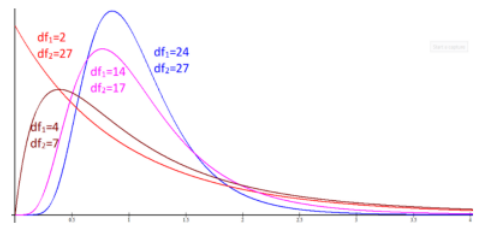
Figure 9-9
We will use the F-distribution in several types of hypothesis testing. For now, we are just learning how to find the critical value and probability using the F-distribution.
Use the TI-89 Distribution menu; or in Excel F.INV to find the critical values for the F-distribution for tail areas only, depending on the degrees of freedom. When finding a probability given an F-score, use the calculator Fcdf function under the DISTR menu or in Excel use F.DIST. Note that the TI-83 and TI-84 do not come with the INVF function, but you may be able to find the program online or from your instructor.
Alternatively, use the calculator at https://homepage.divms.uiowa.edu/~mbognar/applets/f.html which will also graph the distribution for you and shade in one tail at a time. You will see the shape of the F-distribution change in the following examples depending on the degrees of freedom used. For your own sketch just make sure you have a positively skewed distribution starting at zero.
The critical values F\(\alpha\)/2 and F1–\(\alpha\)/2 are for a two-tailed test on the F-distribution curve with area 1 – \(\alpha\) between the critical values as shown in Figure 9-10. Note that the distribution starts at zero, is positively skewed, and never has negative F-scores.
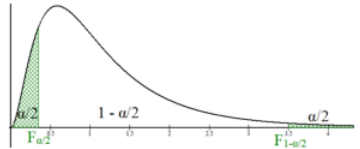
Figure 9-10
Compute the critical values F\(\alpha\)/2 and F1–\(\alpha\)/2 with df1 = 6 and df2 = 14 for a two-tailed test, \(\alpha\) = 0.05.
Solution
Start by drawing the curve and finding the area in each tail. For this case, it would be an area of \(\alpha\)/2 in each tail. Then use technology to find the F-scores. Most technology only asks for the area to the left of the F-score you are trying to find. In Excel the function for F\(\alpha\)/2 is F.INV(area in left-tail,df1,df2).
There is only one function, so use areas 0.025 and 0.975 in the left tail. For this example, we would have critical values F0.025 = F.INV(0.025,6,14) = 0.1888 and F0.975 = F.INV(0.975,6,14) = 3.5014. See Figure 9-11.
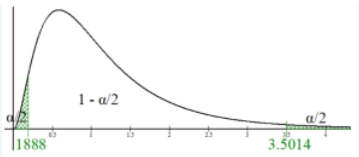
Figure 9-11
We have to calculate two distinct F-scores unlike symmetric distribution where we could just do ±z-score or ±t-score.
Note if you were doing a one-tailed test then do not divide alpha by two and use area = \(\alpha\) for a left-tailed test and area = 1 – \(\alpha\) for a right-tailed test.
Find the critical value for a right-tailed test with denominator degrees of freedom of 12 and numerator degrees of freedom of 2 with a 5% level of significance.
Solution
Draw the curve and shade in the top 5% of the upper tail since \(\alpha\) = 0.05, see Figure 9-12. When using technology, you will need the area to the left of the critical value that you are trying to find. This would be 1 – \(\alpha\) = 0.95. Then identify the degrees of freedom. The first degrees of freedom are the numerator df, therefore df1 = 2. The second degrees of freedom are the denominator df, therefore df2 = 12. Using Excel, we would have =F.INV(0.95,2,12) = 3.8853.
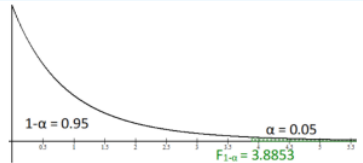
Figure 9-12
Compute P(F > 3.894), with df1 = 3 and df2 = 18
Solution
In Excel, use the function F.DIST(x,deg_freedom1,deg_freedom2,cumulative). Always use TRUE for the cumulative. The F.DIST function will find the probability (area) below F. Since we want the area above F we would need to also use the complement rule. The formula would be =1-F.DIST(3.894,3,18,TRUE) = 0.0263.
TI-84: The TI-84 calculator has a built in F-distribution. Press [2nd] [DISTR] (this is F5: DISTR in the STAT app in the TI-89), then arrow down until you get to the Fcdf and press [Enter]. Depending on your calculator, you may not get a prompt for the boundaries and df. If you just see Fcdf( then you will need to enter each the lower boundary, upper boundary, df1, and df2 with a comma between each argument. The lower boundary is the 3.394 and the upper boundary is infinity (TI-83 and 84 use a really large number instead of ∞), then enter the two degrees of freedom. Press [Paste] and then [Enter], this will put the Fcdf(3.894,1E99,3,18) on your screen and then press [Enter] again to calculate the value.

Figure 9-13.
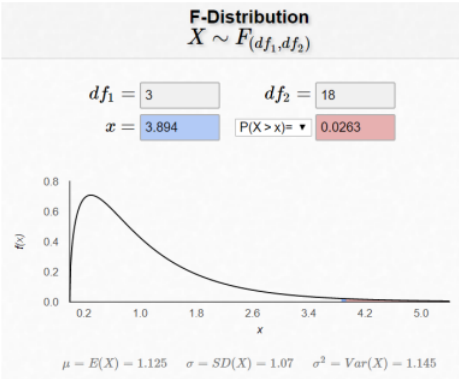
Figure 9-13
9.5.2 Hypothesis Test for Two Variances
Sometimes we will need to compare the variation or standard deviation between two groups. For example, let’s say that the average delivery time for two locations of the same company is the same but we hear complaint of inconsistent delivery times for one location. We can use an F-test to see if the standard deviations for the two locations was different.
There are three types of hypothesis tests for comparing the ratio of two population variances , see Figure 9-14.
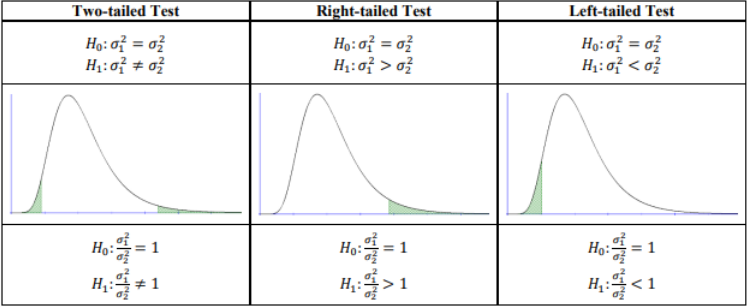
Figure 9-14
If we take the square root of the variance, we get a standard deviation. Therefore, taking the square root of both sides of the hypotheses, we can also use the same test for standard deviations. We use the following notation for the hypotheses.
There are 3 types of hypothesis tests for comparing the population standard deviations σ1/σ2, see Figure 9-15.

Figure 9-15
The F-test is a statistical test for comparing the variances or standard deviations from two populations.
The formula for the test statistic is \(F=\frac{s_{1}^{2}}{s_{2}^{2}}\).
With numerator degrees of freedom = Ndf = n1 – 1, and denominator degrees of freedom = Ddf = n2 – 1.
This test may only be used when both populations are independent and normally distributed.
Important: This F-test is not robust (a statistic is called “robust” if it still performs reasonably well even when the necessary conditions are not met). In particular, this F-test demands that both populations be normally distributed even for larger sample sizes. This F-test yields unreliable results when this condition is not met.
The traditional method (or critical value method), and the p-value method are performed with steps that are identical to those when performing hypothesis tests from previous sections.
A researcher claims that IQ scores of university students vary less than (have a smaller variance than) IQ scores of community college students. Based on a sample of 28 university students, the sample standard deviation 10, and for a sample of 25 community college students, the sample standard deviation 12. Test the claim using the traditional method of hypothesis testing with a level of significance \(\alpha\) = 0.05. Assume that IQ scores are normally distributed.
Solution
1. The claim is “IQ scores of university students (Group 1) have a smaller variance than IQ scores of community college students (Group 2).”
This is a left-tailed test; therefore, the hypotheses are: \(\begin{aligned}
&H_{0}: \sigma_{1}^{2}=\sigma_{2}^{2} \\
&H_{1}: \sigma_{1}^{2}<\sigma_{2}^{2}
\end{aligned}\).
2. We are using the F-test because we are performing a test about two population variances. We can use the F-test only if we assume that both populations are normally distributed. We will assume that the selection of each of the student groups was independent.
The problem gives us s1 = 10, n1 = 28, s2 = 12, and n2 = 25.
The formula for the test statistic is \(F=\frac{s_{1}^{2}}{s_{2}^{2}}=\frac{10^{2}}{12^{2}}=0.6944\).
3. The critical value for a left-tailed test with a level of significance \(\alpha\) = 0.05 is found using the invF program or Excel. See Figure 9-16.
Using Excel: The critical value is F\(\alpha\) =F.INV(0.05,27,24) = 0.5182.
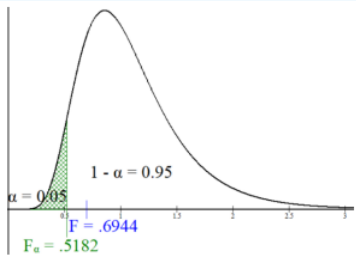
Figure 9-16
4. Decision: Compare the test statistic F = 0.6944 with the critical value F\(\alpha\) = 0.5182, see Figure 9-16. Since the test statistic is not in the rejection region, we do not reject H0.
5. Summary: There is not enough evidence to support the claim that the IQ scores of university students have a smaller variance than IQ scores of community college students.
A random sample of 20 graduate college students and 18 undergraduate college students indicated these results concerning the amount of time spent in volunteer service per week. At \(\alpha\) = 0.01 level of significance, is there sufficient evidence to conclude that graduate students have a higher standard deviation of the number of volunteer hours per week compared to undergraduate students? Assume that number of volunteer hours per week is normally distributed.
A researcher is studying the variability in electricity (in kilowatt hours) people from two different cities use in their homes. Random samples of 17 days in Sacramento and 16 days in Portland are given below. Test to see if there is a difference in the variance of electricity use between the two cities at α = 0.10. Assume that electricity use is normally distributed, use the p-value method.

Solution
The populations are independent and normally distributed.
The hypotheses are \(\begin{aligned}
&\mathrm{H}_{0}: \sigma_{1}^{2}=\sigma_{2}^{2} \\
&\mathrm{H}_{1}: \sigma_{1}^{2} \neq \sigma_{2}^{2}
\end{aligned}\)
Use technology to compute the standard deviations and sample sizes. Enter the Sacramento data into list 1, then do 1-Var Stats L1 and you should get s1 = 163.2362 and n1 = 17. Enter the Portland data into list 2, then do 1-Var Stats L2 and you should get s2 = 179.3957 and n2 = 16. Alternatively, use Excel’s descriptive statistics.
The test statistic is
The p-value would be double the area to the left of F = 0.82796 (Use double the area to the right if the test statistic is > 1).
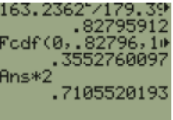
Using the TI calculator Fcdf(0,0.82796,16,15).
In Excel we get the p-value =2*F.DIST(E8,E7,F7,TRUE) = 0.7106.
Since the p-value is greater than alpha, we would fail to reject H0.
There is no statistically significant difference between variance of electricity use between Sacramento and Portland.
Excel: When you have raw data, you can use Excel to find all this information using the Data Analysis tool. Enter the data into Excel, then choose Data > Data Analysis > F-Test: Two Sample for Variances.
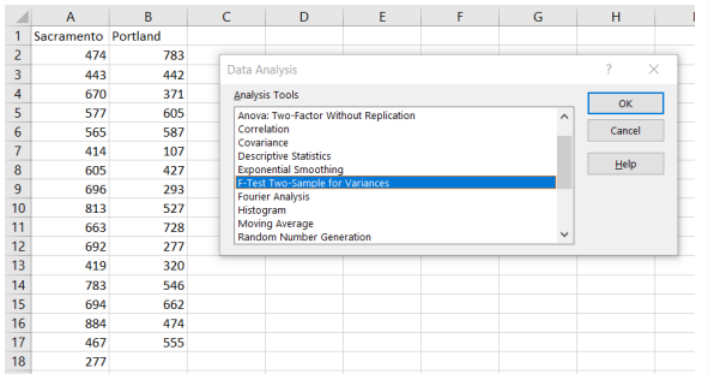
Enter the necessary information as we did in previous sections (see below) and select OK. Note that Excel only does a one-tail F-test so use \(\alpha\)/2 = 0.10/2 = 0.05 in the Alpha box.

We get the following output. Note you can only use the critical value in Excel for a left-tail test.

Excel for some reason only does the smaller tail area for the F-test, so you will need to double the p-value for a two-tailed test, p-value = 0.355275877*2 = 0.7106.



